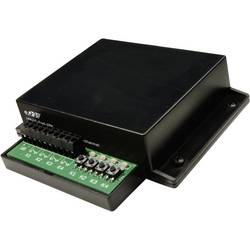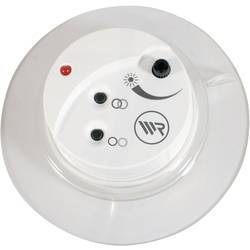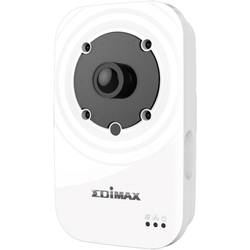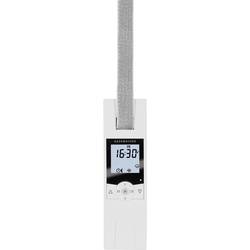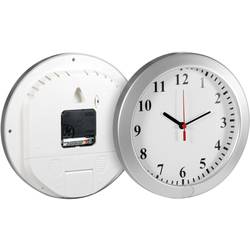€69.11
Priemerné hodnotenie:0/5(0x)
Vlastnosti a parametre výrobku
Skúsenosti užívateľov
Otázky a odpovede
Dokumentácia
Popis
Vlastnosti a parametre výrobku
| Séria (domáca technika) | Homematic |
|---|---|
| Cloudová integrácia (Smart Home) | Conrad Connect (CONRAD-CONNECT_SY_01) |
| Bezdrôtové zariadenie (Smart Home) | Hersteller-Spezifisch |
| Spôsob ochrany | IP20 |
| Napájanie | 230 V |
| Prevádzkové napätie | 7 V/DC 15 V/DC |
| Kanálov | 4 |
| Max. dosah | 300 m |
| Vonkajšia šírka | 84 mm |
| Vonkajšia výška | 72 mm |
| Kategória výrobku | Spínač pohonu |
Skúsenosti a názory zákazníkov
- Skúsenosti užívateľov nie sú k dispozícii.
Otázky užívateľov
- Užívatelia k tomuto výrobku zatiaľ nemali žiadne otázky.
Dokumentácia
Podmienky používania dokumentácie
Bedienungsanleitung (S. 2) Operating manual (p. 16) Schaltaktor Wandmontage: Switch actuator for wall mounting: HM-LC-Sw4-WM
2
1. Ausgabe Deutsch 03/2011
Dokumentation © 2011 eQ-3 Ltd., Hong Kong Alle Rechte vorbehalten. Ohne schriftliche Zustimmung des Herausgebers darf dieses Handbuch auch nicht auszugsweise in irgendeiner Form reproduziert werden oder unter Verwendung elektronischer, mechanischer oder chemischer Verfahren vervielfältigt oder verarbeitet werden.
Es ist möglich, dass das vorliegende Handbuch noch drucktechnische Mängel oder Druckfehler aufweist. Die Angaben in diesem Handbuch werden jedoch regelmäßig überprüft und Korrekturen in der nächsten Ausgabe vorgenommen. Für Fehler technischer oder drucktechnischer Art und ihre Folgen übernehmen wir keine Haftung.
Alle Warenzeichen und Schutzrechte werden anerkannt.
Printed in Hong Kong Änderungen im Sinne des technischen Fortschritts können ohne Vorankündigung vorgenommen werden.
99083 / V 1.0
3
Inhaltsverzeichnis 1 Hinweise zu dieser Anleitung …4
2 Gefahrenhinweise …5
3 Funktion …6
4 Allgemeine Systeminformation zu HomeMatic …7
5 Allgemeine Hinweise zum Funkbetrieb …8
6 Installation …9
7 Inbetriebnahme …10
7.1 Einfache Bedienfunktionen mit angeschlossenen Tastern …10
7.2 Anlernen …11
8 Bedienung …11
9 Zurücksetzen in den Auslieferungszustand …12
10 Rückmeldungen der Kanal-LED …12
10.1 Blinkcodes …12
10.2 Anzeige des Betriebszustandes …13
11 Verhalten nach Spannungswiederkehr …13
12 Wartung und Reinigung …14
13 Technische Daten …15
4
1 Hinweise zu dieser Anleitung Lesen Sie diese Anleitung sorgfältig, bevor Sie ihre HomeMatic Komponenten in Betrieb nehmen.
Bewahren Sie die Anleitung zum späteren Nachschlagen auf!
Wenn Sie das Gerät anderen Personen zur Nutzung überlassen, übergeben Sie auch diese Bedienungsanleitung.
Benutzte Symbole: Achtung! Hier wird auf eine Gefahr hingewiesen.
Hinweis. Dieser Abschnitt enthält zusätzliche wichtige Informationen!
5
2 Gefahrenhinweise Betreiben Sie das Gerät nur in Innenräumen und vermeiden Sie den Einfluss von Feuchtigkeit, Staub sowie Sonnen- oder andere Wärmebestrahlung.
Belasten Sie die Geräte nur bis zur angegebenen Leistungsgrenze. Eine Überlastung kann zur Zerstörung des Gerätes, zu einem Brand oder elektrischen Unfall führen.
Beachten Sie beim Anschluss an die Geräteklemmen die hierfür zulässigen Leitungen und Leitungsquerschnitte.
6
3 Funktion Die Aktoren steuern angeschlossene Verbraucher aufgrund von empfangenen Funkbefehlen.
Befehle werden durch Betätigung von Tastern, Fernbedienungen oder über eine Softwareoberfläche ausgesandt. Zusätzlich ist es möglich, Aktoren über angelernte Sensoren anzusteuern. Die Sensoren senden (wie ein Taster) beim Eintreten eines Ereignisses einen Befehl. Genaueres dazu ist der Anleitung des entsprechenden Sensors zu entnehmen.
A Kanaltasten B Anschlussklemmen zu schaltende Last C Klemmen Versorgungsspannung C
BA
7
4 Allgemeine Systeminformation zu HomeMatic Dieses Gerät ist Teil des HomeMatic Haussteuersystems und arbeitet mit dem bidirektionalen BidCoS
® Funkprotokoll.
Alle Geräte werden mit einer Standardkonfiguration ausgeliefert. Darüber hinaus ist die Funktion des Gerätes über ein Programmiergerät und Software konfigurierbar. Welcher weitergehende Funktionsumfang sich damit ergibt, und welche Zusatzfunktionen sich im HomeMatic System im Zusammenspiel mit weiteren Komponenten ergeben, entnehmen Sie bitte dem HomeMatic Systemhandbuch.
Alle technischen Dokumente und Updates finden Sie stets aktuell unter www.HomeMatic.com.
8
5 Allgemeine Hinweise zum Funkbetrieb Die Funk-Übertragung wird auf einem nicht exklusiven Übertragungsweg realisiert weshalb Störungen nicht ausgeschlossen werden können.
Weitere Störeinflüsse können hervorgerufen werden durch Schaltvorgänge, Elektromotoren oder defekte Elektrogeräte.
Die Reichweite in Gebäuden kann stark von der im Freifeld abweichen. Außer der Sendeleistung und den Empfangseigenschaften der Empfänger spielen Umwelteinflüsse wie Luftfeuchtigkeit neben baulichen Gegebenheiten vor Ort eine wichtige Rolle.
Hiermit erklärt die eQ-3 Entwicklung GmbH, dass sich dieses Gerät in Übereinstimmung mit den grundlegenden Anforderungen und den anderen relevanten Vorschriften der Richtlinie 1999/5/EG
befindet.
Die vollständige Konformitätserklärung finden Sie unter www.HomeMatic.com.
9
6 Installation KurzbezeichnungBedeutung UBKlemmen Versorgungsspannung K1 – K4Klemmen Relaiskontakt, potentialfreie Schliesser
10
Zugelassene Leitungsquerschnitte zum Anschluss an die AP-Aktoren: starre Leitung [mm2]flexible Leitung ohne Aderendhülse [mm 2] flexible Leitung mit Aderendhülse [mm2] 0,4 – 1,50,34 – 1,500,34 – 1,00
7 Inbetriebnahme 7.1 Einfache Bedienfunktionen am Gerät Am Gerät befindet sich pro Kanal ein Bedientaster.
Sie können den Aktor über diese sofort bedienen (Anlernen nicht erforderlich) und die korrekte elektrische Installation überprüfen.
Zum Bedienen wird nur der kurze Tastendruck verwendet. Der lange Tastendruck (länger als 4 Sekunden) versetzt den Aktor in den Anlernmodus.
11
7.2 Anlernen Bitte lesen Sie diesen Abschnitt erst vollständig, bevor sie mit dem Anlernen beginnen!
– ZumAnlernenmüssenbeidezuverknüpfenden Geräte in den Anlernmodus gebracht und der gewünschte Kanal zum Anlernen ausgewählt werden.
– ZumAnlernenaneinenbestimmtenKanaldesAktors halten Sie die zugehörige Kanaltaste (K1–K4) für etwa 4 Sekunden lang gedrückt.
Dauerhaftes Blinken der Kanal-LED signalisiert den Anlernmodus.
– WennkeinAnlernenerfolgt,wirdderAnlernmodus automatisch nach 20 Sekunden beendet. Befinden sich andere Geräte im Anlernmodus, werden diese angelernt.
8 Bedienung Nach dem Anlernen stehen einfache Bedienfunktionen über die angelernten Bedienelemente zur Verfügung.
Je nach angelerntem Bedienelement lässt sich der Schaltaktor im Zweitasten-AN/AUS Betrieb oder im Toggle-Bertrieb ansteuern.
12
9 Zurücksetzen in den Auslieferungszustand Um den Aktor in den Auslieferungszustand zurückzuversetzen, gehen Sie wie folgt vor: – VersetzenSiedasGerätüberdie(K1)Kanaltaste in den Anlernmodus (mindestens 4 Sekunden Taste gedrückt halten).
– BefindetsichdasGerätimAnlernmodus,haltenSie erneut die (erste) Kanaltaste für mindestens 4 Sekunden gedrückt.
– SchnellesBlinkenderGeräte-LEDzeigtan,dassder Aktor in den Werkszustand zurückversetzt wird.
10 Rückmeldungen der Kanal-LED
10.1 Blinkcodes Verschiedene Zustände des Aktors werden durch Blinken der Kanal-LED/Kanal-LEDs angezeigt: BlinkfolgeStatus Langsames BlinkenAnlernmodus Schnelles BlinkenReset Einmal lang, n-mal kurz (je nach Fehlerart)Fehler
13
10.2 Anzeige des Betriebszustandes Sobald das Relais eines Kanals angezogen ist, leuchtet die entsprechende Kanal-LED dauerhaft.
Nach Konfiguration des Aktors über die Zentrale oder über ein Programmiertool zeigt die GeräteLED neben den beschriebenen noch zusätzliche Zustände des Geräts an.
11 Verhalten nach Spannungswiederkehr Nach dem Einschalten der Betriebsspannung (Wiederkehr der Netzspannung) überprüft der Aktor seine Komponenten. Sollte dabei ein Fehler festgestellt werden, wird dieses durch gemeinsames Blinken aller Kanal-LEDs dargestellt. Dieses wiederholt sich kontinuierlich und das Gerät nimmt seine eigentliche Funktion nicht auf.
Sollte der Test ohne Fehler durchlaufen, sendet der Aktor ein Funktelegramm mit seiner Statusinformation aus. Damit bei Spannungswiederkehr (etwa nach Netzspannungsausfall oder Abschaltung) nicht alle Aktoren gleichzeitig senden, wartet der Aktor eine zufällige Verzögerungszeit vor dem
14
Senden. In dieser Zeit blinken die Kanal-LEDs (wie im Anlernmodus). Ist die Verzögerungszeit sehr kurz, kann es sein, dass das Blinken kaum wahrnehmbar ist.
12 Wartung und Reinigung Das Produkt ist wartungsfrei. Überlassen Sie eine Reparatur einer Fachkraft.
15
13 Technische Daten Funkfrequenz: 868,3 MHz Typ. Freifeldreichweite: 300 m Spannungsversorgung: 7–15 V
DCStromaufnahme: 26 mA
Standby-Verbrauch: 0,2 W
Relais: 4 x Schliesser Schaltvermögen: 1 A (ohmsche Last)/ 42 V
DC, 30 VACAbmessungen (B x H x T): 89 x 99 x 26 mm EntsorgungshinweisGerät nicht im Hausmüll entsorgen!
Elektronische Geräte sind entsprechend der Richtlinie über Elektro- und ElektronikAltgeräte über die örtlichen Sammelstellen für Elektronik-Altgeräte zu entsorgen.
Das CE-Zeichen ist ein Freiverkehrszeichen, das sich ausschließlich an die Behörden wendet und keine Zusicherung von Eigenschaften beinhaltet.
16
1st English edition 03/2011
Documentation © 2011 eQ-3 Ltd., Hong Kong.
All rights reserved. This manual may not be reproduced in any format, either in whole or in part, nor may it be duplicated or edited by electronic, mechanical or chemical means, without the written consent of the publisher. Typographical and printing errors cannot be excluded. However, the information contained in this manual is reviewed on a regular basis and any necessary corrections will be implemented in the next edition. We accept no liability for technical or typographical errors or the consequences thereof.
All trademarks and industrial property rights are acknowledged.
Printed in Hong Kong.
Changes may be made without prior notice as a result of technical advances.
99083 / V 1.0
17
Table of contents 1 Information about this manual …18
2 Hazard information …19
3 Function …20
4 General system information about HomeMatic …21
5 General information about radio operation …22
6 Installation …23
7 Start-up …24
7.1 Simple operator functions on the device …24
7.2 Teaching-in …25
8 Operation …25
9 Resetting to the initial state…26
10 Channel LED feedback …26
10.1 Flashing codes …26
10.2 Operating status display …27
11 Response to power recovery …27
12 Maintenance and cleaning …28
13 Technical data …29
18
1 Information about this manual Read this manual carefully before starting to use your device.
Keep the manual so you can refer to it at a later date should you need to.
If you hand over the device to other persons for use, please hand over the operating manual as well.
Symbols used: Attention!
This indicates a hazard.
Note. This section contains additional important information.
19
2 Hazard information The device may only be operated indoors and must be protected from the effects of damp and dust, as well as solar or other methods of heat radiation.
Do not exceed the capacity specified for the device. Exceeding this capacity could lead to the destruction of the device, to a fire or to an electrical accident.
When connecting to the device terminals, take the permissible cables and cable cross sections into account.
20
3 Function Actuators control connected loads in accordance with the wireless commands they receive.
Commands are transmitted by actuating buttons or remote controls, or via a software interface. It is also possible to control actuators via taught-in sensors.
When an event occurs, the sensors transmit a command (in the same way as a button). Refer to the manual for the corresponding sensor for more detailed information.
A Channel buttons B Connecting terminals for the load to be controlledC Supply voltage terminalsC
BA
21
4 General system information about HomeMatic This device is part of the HomeMatic home control system and works with the bi-directional BidCoS® wireless protocol. All devices are delivered in a standard configuration. The functionality of the device can also be configured with a programming device and software. The additional functions that can be made available in this way and the supplementary functions provided by the HomeMatic system when it is combined with other components are described and in the HomeMatic System Manual.
All current technical documents and updates are provided at www.HomeMatic.com.
22
5 General information about radio operation Radio transmission is performed on a non-exclusive transmission path, which means that there is a possibility of interference occurring. Interference can also be caused by switching operations, electrical motors or defective electrical devices.
The range of transmission within buildings can differ greatly from that available in the open air. Besides the transmitting power and the reception characteristics of the receiver, environmental factors such as humidity in the vicinity have an important role to play, as do on-site structural/screening conditions.
eQ-3 Entwicklung GmbH hereby declares that this device complies with the essential requirements and other relevant regulations of Directive 1999/5/EC.
You can find the full declaration of conformity at www.HomeMatic.com.
23
6 Installation AbbreviationDescription UBTerminals for supply voltage K1 – K4Terminals for relay contact, floating NO contacts 12 V power supply unit 12 V relay with 230 V contacts
24
Permitted cable cross sections for connecting to AP actuators: Rigid cable [mm2]Flexible cable without ferrule [mm 2] Flexible cable with ferrule [mm2] 0.4 – 1.50.34 – 1.500.34 – 1.00
7 Start-up 7.1 Simple operator functions on the device The device features one control button per channel.
You can operate the actuator by means of these buttons immediately (no teaching-in required) and check that the electrical installation has been performed correctly.
Simply press and release the button to operate the actuator. A long button press (longer than four seconds) will switch the actuator to teach-in mode.
25
7.2 Teaching-in Please read this entire section before starting the teach-in procedure.
– Toexecutetheteach-inprocedure,bothofthe devices to be connected must be in teach-in mode and the channel to be taught-in must be selected.
– Toteach-intoaparticularactuatorchannel,holdthe corresponding channel button (K1–K4) down for approximately four seconds. If the channel LED flashes continuously, this signals that teachin mode is active.
– Ifnoteach-inoperationsarecarriedout,teach-in mode will be exited automatically after 20
seconds. If other devices are also in teach-in mode, they will be taught-in.
8 Operation After teach-in has been performed, simple operator functions are available via the taught-in control elements. Depending on the taught-in control element, the switch actuator can be controlled by means of an ON/OFF pair of buttons or by toggling.
26
9 Resetting to the initial state To reset the actuator to the initial state, do the following: – Putthedeviceintoteach-inmodeusingthe (K1) channel button (hold it down for at least 4 seconds).
– Ifthedeviceisinteach-inmode,holdthe(K1) channel button down for at least 4 seconds again.
– IfthedeviceLEDflashesquickly,thisindicatesthat the actuator is being reset.
10 Channel LED feedback 10.1 Flashing codes Various actuator states are indicated by the channel LED(s) flashing: Flashing sequenceState Slow flashing Teach-in mode Fast flashing Reset One long flash, n brief flashes (depending on the type of error)Error
27
10.2 Operating status display As soon as a channel’s relay is picked up, the corresponding channel LED lights up continuously.
Once the actuator has been configured via the central control unit or a programming tool, the device LED will indicate other device states in addition to those already described.
11 Response to power recovery When the operating voltage is switched on (recovery of mains voltage), the actuator checks its components. If an error is detected during this process, this is indicated by all the channel LEDs flashing simultaneously. This is repeated continuously and the device does not perform its function.
If the test is completed without errors, the actuator transmits a wireless telegram containing its status information.
To prevent all actuators from transmitting at the same time when power is recovered (after a mains power failure or a disconnection, for example), there is a random delay before the actuator transmits.
28
During this time, the channel LEDs flash (as in teach-in mode). If the delay is very short, this flashing may be almost imperceptible.
12 Maintenance and cleaning The product does not require any maintenance.
Enlist the help of an expert to carry out any repairs.
29
13 Technical data Radio frequency: 868.3 MHz Typ. open air range: 300 m Power supply: 7–15 VDC
Current consumption: 26 mA
Standby consumption: 0.2 W
Relay: 4 x NO contacts Switching capacity: 1A (resistive load)/ 42 V
DC, 30 VACDimensions (W x H x L): 89 x 99 x 26 mm Instructions for disposalDo not dispose of the device with regular domestic waste. Electronic equipment must be disposed of at local collection points for waste electronic equipment in compliance with the Waste Electrical and Electronic Equipment Directive.
The CE Marking is simply an official symbol relating to the free movement of a product; it does not warrant a product’s characteristics.
30
31
eQ-3 AG
Maiburger Straße 29
D-26789 Leer www.eQ-3.com

